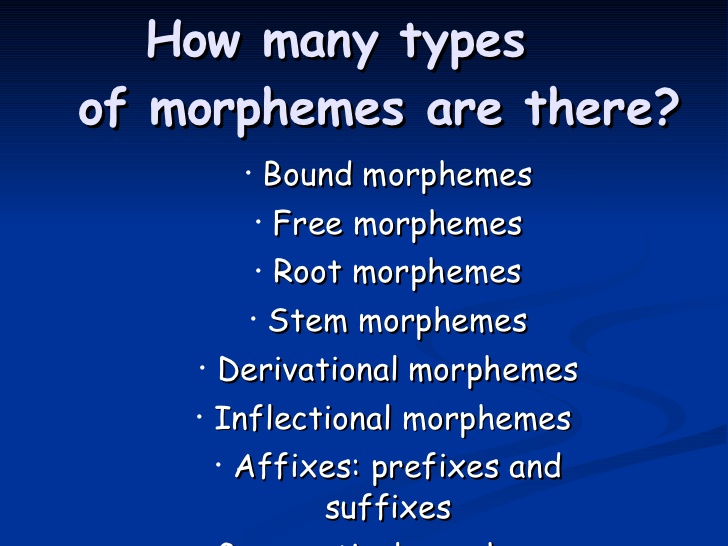We will explain Types of Morphemes in detail. Morphology is the study of the formation of words and their variations Morphemes are linguistic units that are added to the root to form a word.
Free or independent morphemes
There is another class of morphemes called independent or free morphemes that are not tied to any lexeme but convey grammatical meaning of the words with which they are associated. Determinants, prepositions and conjunctions may act as free morphemes. Almost all of them are unstressed. For example: Cat,fan,chair,cut, color,share.
An example of this is found in English the word atlas. Here the morpheme is not present, and that is precisely the reason why the number is singular. Another example is gender morphs names or adjectives ending in a consonant.
Dependent or Bound morphemes:
These morphemes must be attached to the words. They are dependent with words. Prefixes, affixes, infixes, and circumfixes are attached to the words. For example
Include (IN), exclude (ex), unity (UN) involve (IN) etc.
Affixes morpheme:
There are normally two types of affixes. These are prefixes and suffixes. Prefixes are the kind of morpheme that is added at the beginning of the word. It cannot stand alone for example: beautiful (beau), refined (RE), ignorant (IG), etc.
Suffixes Morphemes
Suffixes are the kind of morphemes that add at the ending of words such as capable ( able), flawless ( less) ignorant ( ant), surprise ( se) etc. They always come after the base morpheme.
Infixes Morphemes
In English infixes are the rare morphemes. These are placed within the word. These can be inserted with other morpheme. Hydrogenation, carbon dies oxides, awfully, blooming etc.
Circumfixes Morphemes
It is the combination of affixes, suffixes and infixes in a word. For example a and ing in a going, aback, aside etc.
How To Teach Types of Morphemes Better Than Anyone Else
Root morpheme
Root is the primary unit of the word which cannot be divided into smaller parts. It is the basic part and always remains in a word no matter suffixes or affixes are removed or attached. Good, love, walk, run, bottle, are the free root morphemes.
Stem morphemes:
A stem morpheme is made when root morphemes are added with an affixes.
For example:
ROOT : Real
Stem Reliable (able)
Accurate
Inaccurate (in).
Derivational morphemes
Derivational morphemes create new form of words when adds with affixes. These morphemes can usually change grammatical class. They are used to create new words. For example: Pakistanis, drinkable, achievable, modernize, disqualified etc.
Inflection morphemes:
These morphemes do not change the grammatical meaning but the changes of meanings are minimal. They never change part of speech and create predictable meanings. Such as cats, loves, fished, faster, worked.
Morphemes, the smallest units of meaning in a language, can be classified into different types. Here’s a guide in a tabular format:
- Free Morphemes: These are morphemes that can stand alone as a word.
- Example: “book”, “cycle”
- Bound Morphemes: These cannot stand alone and must be attached to other morphemes.
- Example: “-s” (as in books), “-ing” (as in cycling)
- Root Morphemes: The core part of the word that carries the most significant aspect of its meaning.
- Example: “write” in “writer”, “happy” in “unhappy”
- Affixes: These are bound morphemes that are added to a root or stem to modify its meaning or create a new word. Affixes are further subdivided into:
- Prefixes: Added to the beginning of a word. Example: “un-” in “unhappy”
- Suffixes: Added to the end of a word. Example: “-er” in “writer”
- Infixes: Inserted within the root word. Example: “fan-bloody-tastic”
- Circumfixes: Attached to a word by surrounding it. Example: “ge-…-t” in German (gelesen – read)
- Derivational Morphemes: These change the grammatical category or the meaning of a word.
- Example: “kind” (noun) to “unkind” (adjective), “teach” (verb) to “teacher” (noun)
- Inflectional Morphemes: These do not change the grammatical category or meaning but indicate aspects of the grammatical function, like tense, mood, voice, aspect, person, number, gender, and case.
- Example: “-ed” in “walked”, “-s” in “dogs”
This classification helps in understanding how different parts of a word contribute to its meaning and grammatical function.
Conclusion
As we conclude our journey through the world of morphemes, it becomes evident that these small units of meaning play a significant role in constructing words and conveying messages effectively. By understanding the different types of morphemes – free morphemes, prefixes, suffixes, infixes, derivational morphemes, and inflectional morphemes – we gain a deeper appreciation for the complexity and beauty of language. Next time you encounter a new word, take a moment to dissect its morphemes and unravel the layers of significance hidden within. Language truly is a remarkable tapestry woven with the threads of morphemes.
